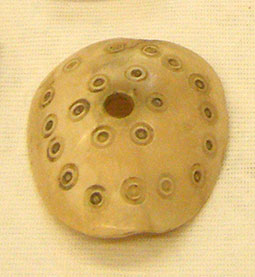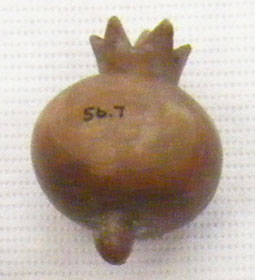Nimrud objects at Cambridge's Museum of Archaeology and Anthropology
Cambridge's Museum of Archaeology and Anthropology (MAA) has the fourth largest collection of Nimrud artefacts in the UK. All of the objects come from excavations carried out in the 1950s by the British School of Archaeology in Iraq. MAA's Nimrud collection contains large numbers of pottery vessels as well as figurines, carved ivory and hands made of clay. Many objects were used in archaeological teaching at the University of Cambridge.

Image 1: Ceramic beakers, bowls and a pipe lamp from MAA's Nimrud collection. These objects were formerly deposited at Cambridge's Faculty of Oriental Studies, hence their accession numbers have a 'D' prefix. Clockwise from bottom left: D 1953.21, D 1953.12 (ND 542?), D 1953.18 (ND1318?), D 1953.19 (ND 54), D 1953.23 (ND 1385). View large image.
The Nimrud project visited MAA in 2013 to view the collection, with the generous assistance of Imogen Gunn, Collections Manager for Archaeology. As the Nimrud artefacts are not currently on display, we viewed and photographed them in the museum's Keyser Workroom. An overview of the collection is presented here with the museum's permission.
MAA's Nimrud objects
MAA's collection of around 50 objects from Nimrud were all dug out of the ground in the 1950s during excavations by the British School of Archaeology in Iraq TT (BSAI). It contains a large number of fine pottery vessels (Image 1) plus small archaeological artefacts including lamps, apotropaic TT figurines TT , and carved ivory TT objects - some of the so-called 'Nimrud ivories' TT . The University of Cambridge gave financial donations towards seven excavation seasons TT at Nimrud between 1952 and 1961 (1), (2), (3), (4), (5) (6), (7) and received gifts of artefacts in return. Cambridge was one of many institutions that received gifts of artefacts in return for financial support. This was a standard method of funding excavations in the mid-20th century, though it is no longer accepted archaeological practice.
Approximately half of the artefacts given to the University of Cambridge went to MAA, and have been in the museum's collection since the 1950s. The other portion was deposited with the Faculty of Oriental Studies (now the Faculty of Asian and Middle Eastern Studies). These artefacts were housed in the Faculty for use in archaeological teaching until the early 2000s, when they were transferred to MAA.
Palace wine cups, the "governor's dinner service" and broken pots
MAA's collection includes palace ware TT beakers, bowls and storage vessels from Nimrud. This fine quality pottery was made for the elite inhabitants of Kalhu's royal residences, including the palaces. One beaker (1956.16) is part of a haul found in storerooms in the northern wing of the Northwest Palace, carefully stored upside down on a shelf just as its Assyrian owners had left it. Other vessels, such as dimpled beaker D 1953.10 (Image 2), come from the residence of Kalhu's governor. The BSAI excavators dubbed this fine-quality pottery the "governor TT 's dinner service".
Yet few pottery vessels emerge from the ground in perfect condition like the "governor's dinner service". They are much more likely to be broken or incomplete. Though broken pieces of pottery are not often displayed in museums, they can be valuable for training archaeologists. MAA's collection also includes a series of broken pieces, or potsherds TT , that represent pottery types from Kalhu in the 8th century BC (MAA 1958.1). Archaeology students at Cambridge used this series to learn how to date Assyrian pottery.
» Read more about the MAA's royal wine cups and teaching collection of pottery.
Clay hands for holding up the palace roof?

Image 3: Two clay hands from Nimrud. Left: uninscribed hand from Room BB in the Governor's Palace, D 1953.22 A (ND 0558). Right: inscribed hand from the Northwest Palace, D 1953.22 B (ND 0635). View large image.
Among the more unusual objects in the collection are two clay hands TT with fingers balled into a fist. MAA's D 1953.22 B (Image 3, left) comes from room BB of the governor's residence and is covered in the remains of a coloured glaze TT . MAA's other hand D 1953.22 A (Image 3, right) has several lines of cuneiform TT inscription written along the fingers. This text describes the hand as property the property of Assurnasirpal II's Northwest Palace. The same inscription is found on other clay hands from the palace (8).
Clay hands were brought back from Assyria by 19th century excavators and were pictured in Layard's Monuments of Nineveh (Image 4) (9). Over 170 clay hands from Assyrian cities are now held in museum collections. Examples discovered at Nimrud during the BSAI excavations are held in the Ashmolean Museum TT and Birmingham Museum in the UK, and worldwide in Australia, Belgium, Denmark, Iraq and the United States. Assyriologists TT still debate the purpose of these clay hands, but they are understood to be architectural fittings from inside buildings. The hands jutted from walls or ceilings, either to support weight or for decorative purposes (10).

Image 4: Two clay hands illustrated as part of a group of "Painted bricks from the N W Palace, Nimroud". Plate 84 from A. H. Layard's Monuments of Nineveh, Volume 1, (1849). View large image.
Found down a well!
Three artefacts in MAA's collection were excavated from a well in Assurnasirpal's Northwest Palace in 1951. They are among a variety of artefacts that were thrown down the well in antiquity, perhaps by invaders ransacking the building.
MAA's objects from the well all have counterpart objects in other museums. When groups of similar artefacts from the BSAI excavations were gifted to museums in the 1950s, they were intentionally separated to give different museums a representative sample.

Image 5: One of 18 decorated shell objects found down a well in Room NN of the Northwest Palace. MAA 1956.06 (ND 2240b).
MAA object 1956.06 (Image 5) is one of 18 shell objects found in the well, each decorated with a pattern of concentric circles. Other examples are held in the Australian Institute of Archaeology, Birmingham Museum and Art Gallery, the British Museum, the Iraq Museum and the Metropolitan Museum of Art. Some shells have a copper nail still attached, indicating that they were once nailed through their centres to another object. Although the exact purpose of these shells is unknown, Assyriologists have suggested they are part of horse harnesses or shields. (11)

Image 6: Carved ivory pomegranate, possibly a decorative bead, approx 3cm in length. MAA 1956.7 (ND 2234a).
MAA object 1966.7, an ivory pomegranate TT (Image 6), is one of seven discovered in the well. Other examples are held in the Australian Institute of Archaeology, the Iraq Museum and the Metropolitan Museum of Art. The ivory pomegranate may be a decorative bead and has a loop at its base for attachment to another object by thread or wire. Similar gold pomegrantes are included in a diadem TT found in the royal tomb II at Nimrud (12). Gold and rock crystal TT examples was also found individually within the tombs (13) (14).
MAA object 1956.5, a bronze TT figurine of a dog, was found with five others down the well. It functioned in antiquity as a protective figurine in a ritual TT to repel evil and prevent it plaguing the inhabitants of a building. After rediscovery, the six model dogs were separated into different museum collection. This separation has affected how MAA's figurine has been understood. Due to its distinctly feline appearance, MAA's model gained a new identity as a cat.
» Read more about MAA's model dog that became a cat.
Content last modified: 18 Dec 2019
References
- Mallowan, M.E.L., 1952. "The Excavations at Nimrud (Kalḫu), 1952", Iraq 15, pp. 1-42 (PDF available via JSTOR for subscribers), p. 1. (Find in text ^)
- Mallowan, M.E.L., 1953. "The Excavations at Nimrud (Kalḫu), 1952", Iraq 15, pp. 1-42 (PDF available via JSTOR [http://www.jstor.org/stable/4199564] for subscribers), p. 1. (Find in text ^)
- Mallowan, M.E.L., 1954. "The Excavations at Nimrud (Kalḫu), 1953", Iraq 16, pp. 59-114 (PDF available via JSTOR [http://www.jstor.org/stable/4199583] for subscribers), p. 60. (Find in text ^)
- Mallowan, M.E.L., 1956. "The Excavations at Nimrud (Kalḫu), 1955", Iraq 18, pp. 1-21 (PDF available via JSTOR [http://www.jstor.org/stable/4199594] for subscribers), p. 1. (Find in text ^)
- Mallowan, M.E.L., 1958. "The Excavations at Nimrud (Kalḫu), 1957", Iraq 20, pp. 101-108 (PDF available via JSTOR [http://www.jstor.org/stable/4199635] for subscribers), p. 102. (Find in text ^)
- Mallowan, M.E.L., 1959. "The Excavations at Nimrud (Kalẖu), 1958", Iraq 21, pp. 93-97 (PDF available via JSTOR [http://www.jstor.org/stable/4199654] for subscribers), p. 94. (Find in text ^)
- Oates, D., 1962. "The Excavations at Nimrud (Kalḫu), 1961", Iraq 24, pp. 1-25 (PDF available via JSTOR [http://www.jstor.org/stable/4199709] for subscribers), p. 1. (Find in text ^)
- Grayson, A.K., 1991. Assyrian Rulers of the Early First Millennium BC: I (1114-859 BC) (Royal Inscriptions of Mesopotamia. Assyrian Periods. Volume 2), Toronto: University of Toronto Press, pp. 373-374, no. A.101.123. (Find in text ^)
- Layard, A.H., 1849-1853. The Monuments of Nineveh: From Drawings Made on the Spot, vols. I–II, London: John Murray (free online edition of vol. 1 and vol. 2). (Find in text ^)
- Frame, G., 1991. "Assyrian clay hands", Baghdader Mitteilungen 22, pp. 335–381, plates 43–47. (Find in text ^)
- Oates, D. and J. Oates, 2001. Nimrud, An Assyrian Imperial City Revealed, London: British School of Archaeology in Iraq ( free PDF from BISI, 128 MB), p. 243. (Find in text ^)
- Collon, D. (ed), 2008. "Nimrud treasures: panel discussion", in J.E. Curtis, H. McCall, D. Collon and L. al-Gailani Werr (eds.), New Light on Nimrud: Proceedings of the Nimrud Conference 11th-13th March 2002, pp. 105-118 (free PDF from BISI), pp. 107, plate 1. (Find in text ^)
- Youkhanna, D. G., 2008. "Precision craftsmanship of the Nimrud gold material", in J.E. Curtis, H. McCall, D. Collon and L. al-Gailani Werr (eds.), New Light on Nimrud: Proceedings of the Nimrud Conference 11th-13th March 2002, pp. 103-104 (free PDF from BISI, 22 MB), p. 103. (Find in text ^)
- Damerji, M., 2008. "An introduction to the Nimrud tombs", in J.E. Curtis, H. McCall, D. Collon and L. al-Gailani Werr (eds.), New Light on Nimrud: Proceedings of the Nimrud Conference 11th-13th March 2002, London: British Institute for the Study of Iraq, pp. 81-82 (free PDF from BISI, 22 MB), pp. 81, 118. (Find in text ^)
Ruth A. Horry
Ruth A. Horry, 'Nimrud objects at Cambridge's Museum of Archaeology and Anthropology', Nimrud: Materialities of Assyrian Knowledge Production, The Nimrud Project at Oracc.org, 2019 [http://oracc.museum.upenn.edu/nimrud/catalogues/ukmuseums/maacambridge/]
